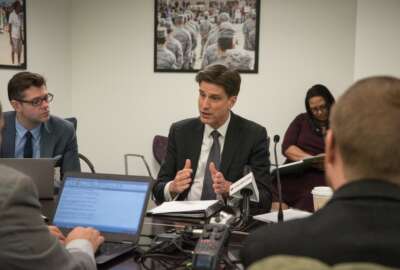

Under the CoE initiative, the Joint AI Center and GSA will focus on JAIC’s mission of accelerating the delivery of AI-enabled capabilities, scaling the depart...
Call it a partnership of convenience. The Defense Department’s Joint Artificial Intelligence Center (JAIC) needed help in growing its technology capabilities. The General Services Administration wants to set up an AI Center of Excellence.
The two agencies announced today they are partnering under the Centers of Excellence initiative to meet both goals. DoD’s JAIC becomes the fifth agency to take part in the Trump administration’s CoE program.
Lt. Gen. Jack Shanahan, director of the JAIC, said on Wednesday at the 2019 George T. Kalaris Intelligence Conference on Artificial Intelligence and National Security that GSA has been forward leaning in reaching out to offer the JAIC assistance.

“On the contracting and acquisition side of it, they have been incredibly helpful. In addition to trying to hire the right people, our other big challenge is contracting and acquisition and moving at the speed of agile methodology. That is a big part of it,” he said. “They have offered to help us pretty much in every single line of effort. Everything from intelligent business automation, or as some would say robotic process automation—we have a start on that—to some other help in other contracting and acquisition and to our joint common foundation, which is that platform that will be common to the JAIC, that will be a place for data, tools, libraries, dev/sec/ops environment, basically platform-as-a-service, they are offering to help us in each one of those areas.”
GSA said in a release that the partnership will focus on JAIC’s mission of accelerating the delivery of AI-enabled capabilities, scaling the departmentwide impact of AI and synchronizing DoD AI activities to expand joint force advantages.
“We believe that the opportunities for applying AI in government are significant,” said Anil Cheriyan, director of the Technology Transformation Service at GSA, in a statement. “As GSA builds its AI Center of Excellence, the addition of JAIC as our fifth partner agency helps us drive ongoing technology transformation in the federal marketplace. We’re proud to be seizing the opportunity with our newest partner, enabling AI to bolster the capabilities of today’s warfighter and build a foundation to reuse our AI expertise to improve citizen experiences across government.”
GSA and the JAIC will enter into the phase 1 of the CoE effort, which focuses on the current state of cloud, data analytics, customer experience, infrastructure optimization and contact center capabilities. It’s unclear if all five if these areas will be the focus for the JAIC’s CoE engagement.
After phase 1, GSA and DoD will decide how to move forward to improve specific areas. For the two previous CoEs that moved past phase 1, the departments of Agriculture and Housing and Urban Development, phase 2 included new acquisitions.
The decision for GSA and DoD to partner on promoting and expanding AI capabilities can be traced back to the administration’s focus on this emerging technology over the last year.
President Donald Trump signed the American AI Initiative executive order in February.
As part of that roll out, DoD officially launched the JAIC and released its new AI strategy, saying the new center will be the main artery delivering AI governance, tools, standards and more to all military services and DoD agencies.
Earlier in September at the Office of Science and Technology Policy’s AI summit, Cheriyan said the goal of the AI Center of Excellence is to help agencies apply AI to drive transformative improvements in government operations.
In the report from the event, OSTP states, “A Center of Excellence (CoE) model can be an important mechanism for agencies to share AI expertise and best practices. Participants discussed the types of information, services and expertise that would be particularly helpful for a CoE to provide, in order to accelerate the use of AI in the government for improved operations and services. Individuals shared their views on the best engagement model between agencies, industry and a CoE to foster partnerships and encourage rapid scaling of AI utilization within the government. They also proposed ideas for types of CoE outreach that could foster cross-organizational communication of best practices for AI adoption.”
The need for an AI CoE is clear as more and more agencies are seeing the value of the technology. The Professional Services Council found in between 2016 and 2018 contract obligations and AI-related investments grew almost 75% to nearly $700 million. The industry association expects the spending on AI to reach more than $1 billion in 2019.
Copyright © 2024 Federal News Network. All rights reserved. This website is not intended for users located within the European Economic Area.
Jason Miller is executive editor of Federal News Network and directs news coverage on the people, policy and programs of the federal government.
Follow @jmillerWFED



